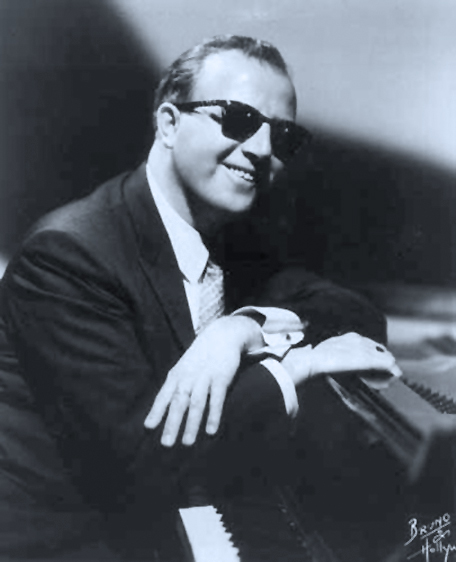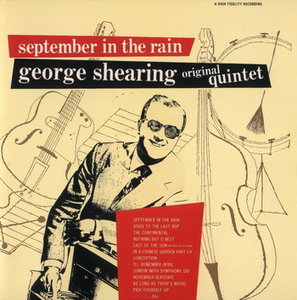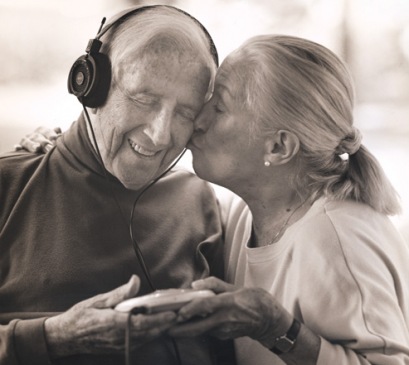‘As Far As Pianists Go, There Will Always Be Only One George Shearing’
August 13, 1919-February 14, 2011
By David McGee
Born in London on August 13, 1919, blind at birth, the son of a coal miner father and a mother who cleaned trains, George Shearing began playing piano as a three-year-old, spent four years of formal training at the Linden Lodge School for the Blind, where he studied Bach, Liszt and music theory, and also became enthralled with jazz through the recordings of American pianists such as Earl Hines, Art Tatum, Fats Waller and Meade Lux Lewis. Through the auspices of the formidable jazz critic, composer and producer Leonard Feather (who had discovered Shearing playing swing accordion at a London jam session, and helped the young musician land a regular radio program on the BBC), the then-18-year-old Shearing began recording in earnest. Also while in his teens, he was a member of an all-blind 15-piece orchestra led by Claude Bampton that favored the music of Duke Ellington and Jimmie Lunceford, and a member of a popular band led by Welsh clarinetist Harry Parry. Shearing appeared on more than 100 recordings, won seven consecutive Melody Maker polls as best jazz pianist, and helped spur the comeback of former Django Rheinhardt collaborator Stephane Grappelli in playing and recording with the jazz violinist.
Emigrating to the United States in 1947, Shearing’s first job was as an intermission pianist at a New York club where Sarah Vaughan was appearing; he did the same at another club during an Ella Fitzgerald appearance, and sometimes filled in for Ella’s pianist, Hank Jones. In 1949, after working with the Oscar Pettiford Trio, he formed his own quintet, found his sound and started making a name for himself on the national scene. In part Shearing’s ascendancy is attributed to the unusual lineup he put together, which included, in addition to his piano and the bass-drums rhythm section, a vibraphone and a guitarist, the latter two being an unusual pairing in a quintet configuration. In his book The Jazz Years: Earwitness to an Era, Leonard Feather—who had a hand in assembling the quintet—credited Shearing with developing “a new and unprecedented blend for his instrumentation.” The quintet would become Shearing’s usual lineup for the next three decades, and through it moved some of the foremost names in jazz, including vibraphonists Gary Burton andCal Tjader, guitarist Joe Pass and Toots Thielemans, who played guitar with Shearing but later became the Mount Olympus of jazz harmonica players.
The Geoge Shearing Quintet, ‘Move’: Don Elliot (vibraphone); Chuck Wayne (guitar); Denzil Best (drums); John Levy (bass).Interviewed by George Spink for the Chicago Sun-Times on December 11, 1977 (now online at Tuxedo Junction.com), Shearing recalled the progression of events that led to his breakthrough and Spink probed one of the original quintet members for her perspective on the pianist’s distinctive style:
"I had John Levy on bass and Denzel Best on drums in tow for a gig at the Clique Club. The owner asked if we'd mind adding Buddy DeFranco on clarinet. Would we mind? Buddy's just about one of the world's greatest clarinet players. So we formed a quartet.
"Buddy was negotiating with Capitol Records,
and I with M-G-M. Our careers couldn't exist
side by side with separate negotiations. So
Leonard Feather and I conceived of maintaining
the rather subdued rhythm section while adding
Marjie Hyams on vibes and Chuck Wayne on
guitar. The five of us—John Levy, Denzil Best,
Marjie Hyams, Chuck Wayne and myself—sat
down at an accidental rehearsal and accidentally
played ‘September in the Rain’ and accidentally
sold 900,000 copies!"The Shearing sound is easily identifiable, emphasizing clear melodic lines, rich harmonies and strong bebop influences.
"Our sound was doubly derivative," Shearing explained, "from the Glenn Miller saxophone section and from Lionel Hampton's pianist, Milt Buckner, who used it in the blues." Shearing was referring to Buckner's locked-hand or block-chord style. The Miller influence was subtler.
Miller voiced the lead clarinet, playing the melody line, in unison with, but one octave higher than, the lead tenor sax, while the other three saxes provided divided harmonies. Shearing voiced the guitar (without vibrato) one octave higher than the vibes (without a motor), both playing the melody in unison while Shearing played harmonies in the block-chord style. The bass and drums remained subdued.
Marjie Hyams (who contributed a number of songs to the original quintet, including the haunting "November Seascape") left Shearing's group in late 1950 and moved to Chicago, where she married Bill Ericsson, a banker. She continued to play professionally and teach music here until recently.
"There was a lot of excitement in that first quintet," she recalled. "All of us worked so well together. George marveled at our ability to outguess him, to sense where he was headed. And we always played behind the beat, adding still another dimension to the distinctive sound of the quintet.
In 1959 the George Shearing Quintet backed Peggy Lee on a faux live album, Beauty and the Beat. Billed as havinag been recorded in Miami at a disc jockeys convention on May 28-29, the actual album was done in a studio and overdubbed with canned applause and announcements. In addition to Shearing, the quintet includes Toots Thielemans, guitar; Ray Alexander, vibraphone; Carl Pruitt, bass; Ray Mosca, drums: Armando Paraza, congas, percussion. Heard here are the three set opening songs: ‘Do I Love You,’ ‘I Lost My Sugar In Salt Lake City’ and ‘If Dreams Come True,’ from the 2003 Blue Note reissue; a later Japanese reissue removes all the applause, announcements and added ambient effects."Today, you can hear something resembling the Shearing sound just riding an elevator. But the initial reaction was one of amazement. Black as well as white audiences accepted us; we even played the Apollo on several occasions. And Miles Davis was one of our biggest fans.
"Perhaps we were too well received by the public. George came to restrain us on our solos, returning to the melody sooner than some of us liked, which is partly why I left. As far as pianists go, though, there will always be only one George Shearing."
In 1952 Shearing wrote himself into post-war musical history with his song “Lullaby of Birdland,” an instant classic if ever there was one. Music business insiders have always been amused by the circumstances of the song’s writing. The Clique, where Shearing had been ensconced with Buddy DeFranco, was owned by the infamous Morris Levy (see Fredric Dannen’s indispensable 1991 tome Hit Men: Power Brokers and Fast Money Inside the Music Business for the basics on Levy’s tainted legacy, or perhaps ask the family of Frankie Lymon, among others), who decided to rename his establishment in honor of the legendary jazz saxophonist Charlie “Bird” Parker, and so Birdland was born.
Writing in his autobiography, Lullaby of Birdland: The Autobiography of George Shearing, Shearing noted that the club, which seated only 175, became a popular nighttime destination when Levy decided to have station WJZ broadcast a show on site. Famous for saying, “You don’t ask, you don’t get,” Levy asked Shearing to record as a theme song for the live broadcast a tune to which Levy held publishing rights. Unimpressed by the song Levy gave him, Shearing said he would write an original number for the show. Levy was happy to go along with this arrangement, so long as he was given publishing rights.
Laboring for weeks to come up with a Birdland tune he thought appropriate, Shearing discarded one idea after another. During dinner one evening, though, the muse visited. Shearing left the table, sat down at the piano and wrote “Lullaby of Birdland” in 10 minutes. “Actually quite a lot of my compositions have come this way,” Shearing wrote in his autobiography. “Very slow going for a week or so, and the finished piece comes together very rapidly. But as I say to those who criticize this method of working, it’s not that I dash something off in ten minutes; it’s ten minutes plus umpteen years in the business.” With its singsong melody shifting from an opening minor key progression into a major key about halfway through, and an easygoing, sensuous rhythm, Shearing’s “Lullaby of Birdland” sounded like one of those songs that had always been there, timeless, unassailable, comforting and romantic. His original 1952 quintet recording followed “September In the Rain” up the charts, became the theme for the radio show, and entered into jazz legend when George David Weiss added lyrics later and Sarah Vaughan recorded a hit version in 1954 with trumpeter Clifford Brown; it was even transformed into a rock ‘n’ roll tune in 1962, when Bill Haley and His Comets worked a variation on it called “Lullaby of Birdland Twist.” (Weiss wrote under the nom de plume of B.Y. Forster in order to avoid detection by the performing rights societies BMI and ASCAP, which prohibited an ASCAP writer to write with a BMI composer.)
George Shearing, ‘Lullaby of Birdland,’ London, 1955Recording his signature song in different styles over the years, Shearing found it a most malleable product. As noted at Jazz Standards.com, “He gave it a Latin feel with vocalist Ernestine Anderson, played it with Tito Puente’s band, and Dick Hyman arranged it for Shearing’s BBC Big Band tour. Shearing recorded it with a new quintet in 1994 and again with different personal in the quintet that he took into the new Birdland in 2000. He has performed it as a duet with two different bassists, Brian Torff and Neil Swainson. In 1982 he and vocalist Mel Torme recorded it in a live performance called An Evening with George Shearing & Mel Torme for which Torme won a Grammy for Best Jazz Vocal Performance, Male. Torme repeated his award the following year, again for a duo performance with Shearing called Top Drawer. While the singer was honored by the awards he was vocal about his chagrin that Shearing was overlooked on both occasions for an effort that was clearly a total collaboration.”
Of the multitude of cover versions of “Lullaby of Birdland,” Shearing held Erroll Garner’s 1953 version in highest esteem. From his autobiography: "When I heard Erroll Garner's recording of the tune, it quickly became my very favorite recording. I wonder why I didn't write it that way—by which I mean I had a fairly brisk tempo in mind, whereas Erroll just took it very gently, he kind of lagged it along and scraped his way through it, so much so that you can almost hear the smile on his face as he's playing. ...After hearing how he tackled 'Lullaby of Birdland,' I came to the conclusion that the composer is not always right about his or her own music. Because when someone else comes up with another idea, they can enrich a piece by hearing something different in it.”
Nat King Cole and George Shearing, from their 1961 album, Nat King Cole Sings/George Shearing Plays: ‘I Got It Bad (and That Ain’t Good),’ a 1941 Duke Ellington hit with lyrics by three-time Academy Award winning songwriter Paul Francis Webster (for ‘Secret Love,’ 1953; ‘Love Is a Many Splendored Thing,’ 1955; and ‘The Shadow of Your Smile,’ 1965; he also wrote the Pat Boone hits ‘April Love’ and ‘Friendly Persuasion,’ both film title songs.A facet of the elegance Shearing brought to his music—in addition to his always impeccable appearance—owed its origin to the classical studies of his youth at the Linden School. He liked to sneak in classical phrases when performing with the quintet, and when his reputation grew to where he was in demand to perform with symphony orchestras, he would play Mozart and Bach during the first half of a concert, jazz in the second. However, the classical phrases that popped up in his quintet repertoire were, he said, more spur of the moment than by design.
“Those ideas just spontaneously came into my head, and that’s the premise on which I used to choose the tunes to play with the quintet,” he told Alan Stevens in a 1979 interview, who pointed out that the tune “If,” from Shearing’s album Light, Airy and Swinging, has a Mozartian flavor. “Now that idea flashed into my mind on the way from my hotel to the studio,” Shearing said, “and we recorded it twenty minutes later.”
His aim in bringing jazz to classical audiences and vice versa he said, was to “turn the heads around of both sides. We draw from the jazz audience, who think that classical music is just a lot of scales, and we draw from the classical audience, who perhaps feel that jazz is nothing more than a lot of noise.”
From the early 1950s on, Shearing recorded steadily, first with MGM, where he was under contract from 1950 to 1955, and then with Capitol Records for 14 years. With Capitol, he recorded albums with some of the finest singers of the day, including Nat King Cole, Peggy Lee and Nancy Wilson, and was a reliable presence on the charts from the late 1950s into the early 1960s.
Eventually the pace of his career began to wear on Shearing—he once told New Yorker jazz critic Whitney Balliett that the quintet had played 56 concerts in 63 days, and his former bassist, Al McKibbon, recalled how one night in Oklahoma City Shearing fell asleep in the middle of a chorus of “Tenderly,” only to wake with a start and “carry right on.”
George Shearing and Mel Torme at the Newport Jazz FestivalDisbanding the quintet in 1978, Shearing performed the rest of his career either solo, or in duo or trio settings. He gained a second wind in 1980s when he recorded for Telarc and Concord. The latter association, of eight years’ duration, was most fruitful, resulting in six outstanding albums with Mel Torme, all of them Grammy nominated, and two—1982’s George Shearing & Me and 1990’s Mel & George ‘Do’ World War II—winning Grammys. (All of the Shearing-Torme recordings are available in a box set, The Complete Concord Recordings, available at the Concord website.) Shearing’s work was also enthusiastically championed by disc jockey Jonathan Schwartz through the years on Schwartz’s shows on WNEW-AM, WQEQ-FM and WNYC-FM public radio, where Shearing became a regular guest on Schwartz’s annual Christmas shows and invariably provided the most tender moments of the always-high-spirited gatherings with his wit, warmth and sensitive playing.
Sir George Shearing and his wife Ellie, at home in Lee, MA.Shearing died of congestive heart failure on February 14, at age 91. While playing in an air-raid shelter during World War II, Shearing met his first wife, Beatrice Bayes (known to friends as Trixie). They married in 1941 and had one daughter, Wendy Ann, before divorcing in the early 1970s. He later married Eleanor Geffert, who survives him, as does his daughter.
Over the years, he played for three U.S. presidents—Gerald Ford, Jimmy Carter and Ronald Reagan—and for Queen Elizabeth II. He was knighted by the Queen in 2006. The occasion of meeting the Queen brought out the impish, low-key wit that endeared Shearing to fans and fellow musicians alike.
"When we were preparing to be received [by the queen], I was told that the directive is: Do not extend your hand until the queen extends hers,” Shearing told Leonard Feather. “I said, ‘Well, either somebody's going to have to cue me or she'll have to wear a bell.’ But somebody did cue me.”
Lullaby of Birdland: The Autobiography of George Shearing is available at www.amazon.com
George Shearing Quintet, ‘I’ll Be Around,’ with Don Elliott (vibraphone), Denzil Best (drums), John Levy (bass), Chuck Wayne (guitar).
Founder/Publisher/Editor: David McGee
Contributing Editors: Billy Altman, Laura Fissinger, Christopher Hill, Derk Richardson
Logo Design: John Mendelsohn (www.johnmendelsohn.com)
Website Design: Kieran McGee (www.kieranmcgee.com)
Staff Photographers: Audrey Harrod (Louisville, KY; www.flickr.com/audreyharrod), Alicia Zappier (New York)
E-mail: thebluegrassspecial@gmail.com
Mailing Address: David McGee, 201 W. 85 St.—5B, New York, NY 10024





